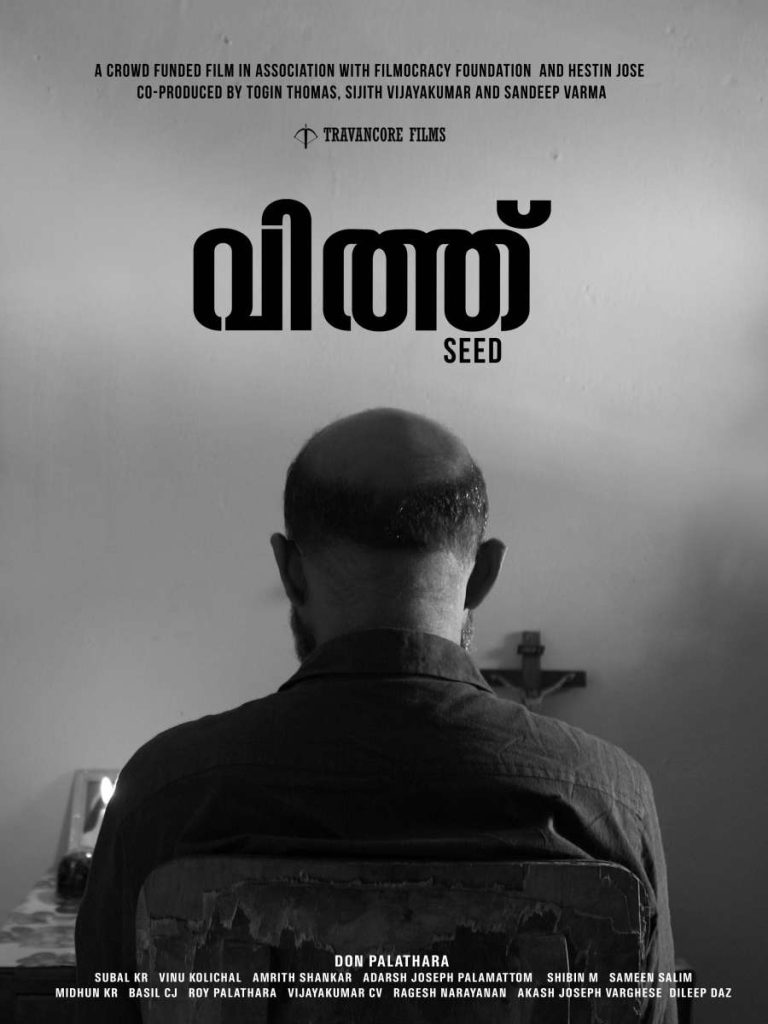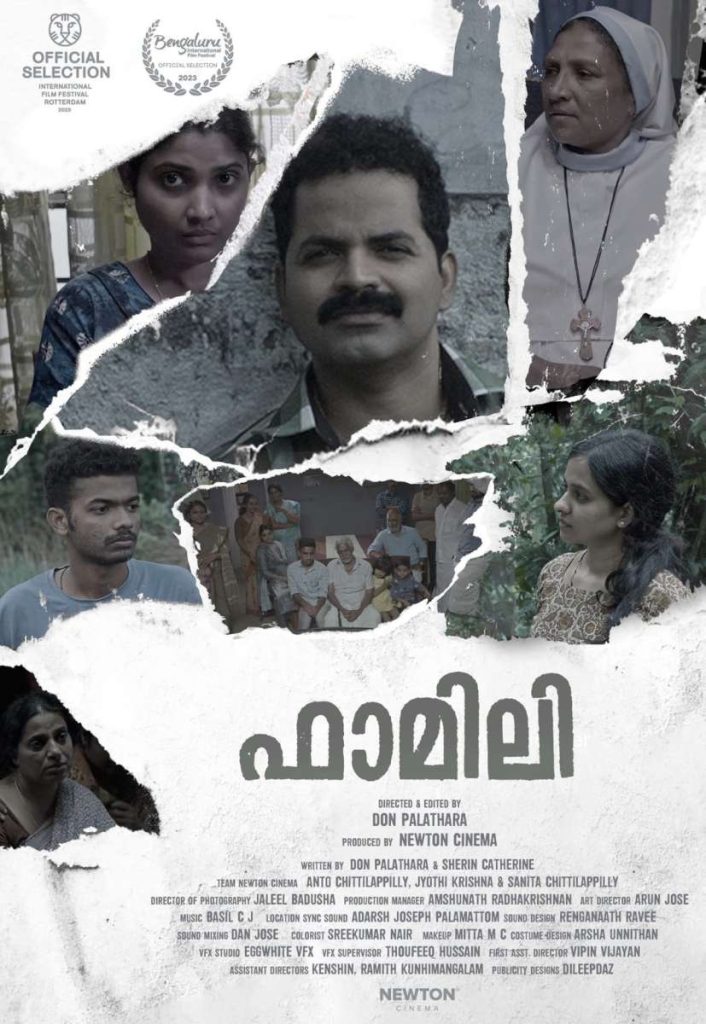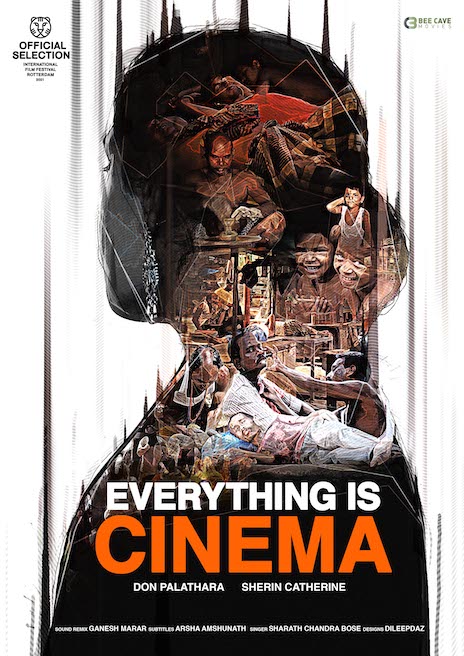I try to explore how religious values and institutions are often intertwined with societal norms and expectations. This can lead to both positive and negative consequences, such as fostering a sense of community and belonging but also potentially reinforcing patriarchal structures or stifling individual expression…Film maker Don Palathara speaks with Krishnaja T. S. and Aswin Prasanth
Don Palathara, an Indian filmmaker, working in the Malayalam film industry, has helmed six full-length feature films and numerous short films. His distinctive storytelling approach has garnered him acclaim, leading to accolades at various international film festivals. Palathara’s debut film Shavam (2015) shot entirely in black and white, employing location-recorded sound, featured a significant cast of inexperienced actors. Despite these unconventional choices, the film emerged as one of the most acclaimed experimental endeavours in Indian cinema, earning widespread appreciation. Palathara’s second film, Vith (2017), was financed through crowdfunding platforms. This innovative approach to film financing gained traction among younger filmmakers, illustrating a departure from traditional methods and showcasing Palathara’s pioneering spirit within the industry. Another experimental venture by Palathara, Santhoshathinte Onnam Rahasyam (2021), stars Rima Kallingal and Jitin Puthanchery in an 85-minute single-take car journey undertaken by a young journalist and an aspiring actor. Captured entirely within the confines of the car, the film, shot during the COVID-19 pandemic, delves into the theme of social entrapment. Its portrayal of the human condition resonated deeply, earning it a nomination for the prestigious Golden George for Best Film at the 43rd Moscow International Film Festival. His Everything Is Cinema (2021) is a first-person narrative drama that exclusively stars Sherin Catherine. It debuted in the Cinema Regained section of the 50th International Film Festival Rotterdam. The film tells the story of Chris, a young, independent filmmaker from Kerala who wants to make his modern version of Louis Malle’s 1969 documentary Calcutta. Like many of his other films showcased at international film festivals, 1956, Central Travancore (2019) made its debut at the Moscow International Film Festival. Palathara’s 2022 film Family, with Vinay Forrt playing the protagonist, was an official selection for the Rotterdam International Film Festival; renowned for its artistic merit, the film showcases unique aesthetics and employs natural sound mechanisms to a remarkable effect.

This interview delves into Don Palathara’s body of work and thematic concerns, with a particular emphasis on the cinematic methodologies he employs across his films.
Shavam depicts the cultural nuances and emotional intricacies around death within a Malayali Christian family by striking a careful balance between humour and melancholy. How do you establish this equilibrium, and how does this subtle depiction subvert popular cinematic myths about death and grief?
While living in Kerala, I have always felt that the grief displayed by people around me was not always an honest expression of their true feelings. There are certain expectations surrounding the performance from relatives and friends. I wanted to focus on the superficiality of these performances in everyday life. During the making of Shavam, I realized that what brings out humour is not a conscious effort to be funny, but rather an objective portrayal of life.
How does Vith portray the interplay between tradition and modernity within the rural context of Central Travancore, specifically examining the divergent attitudes towards work and life embodied by Joseph, the steadfast religious farmer, and his son Jose, who challenges conventional norms by leaving a regular job?
While developing Vith, the intention was to communicate about these two characters and the relationship between them through minimal use of words. Shavam was very loud that way, I felt. So, I wanted to make a calmer and quieter film. So, I decided to employ long takes of mundane life and silence as the characters would experience it. The conflict between the two generations is, for most of the film, internalised. The outward expression occurs only sparsely. Religion is an overarching institution throughout the film and a subtle tool for control between these two people.
In 1956, Central Travancore, the depiction of the protagonist’s desperate plan to engage in illegal hunting of a gaur serves as a metaphor for the broader socio-economic challenges faced by early migrants to Kerala’s Idukki region. Within this framework, how does this metaphor intricately weave together themes of sibling relationships and migration, shedding light on the complexities and hardships faced by individuals navigating familial ties amidst the turbulent backdrop of migration and social change?
While making 1956, Central Travancore, I wanted the film to reflect the spirit of those times rather than be a factual representation of the events. Most of these stories told by various characters in the film, as well as the major plot, are based on some stories told by my grandfather about his younger days. He, like many others, migrated from Kottayam district in the 1950s to Idukki. I am someone who constantly thinks about the nature of relationships between individuals and the societies they are part of. In this film, we also try to explore some themes related to that particular concept. For example, these are characters who do not fully conform to societal norms. But, they have their confusions, personal struggles, and baggage that they bring in from outside the time and space they share.

In Everything is Cinema, your exploration of intertextuality, drawing from Louis Malle’s Calcutta, enriches the reinterpretation of the documentary for a modern audience. Could you elaborate on how texts interplay to portray the present cultural and socio-political landscape? What inspired you to undertake such a comprehensive exploration?
In Everything is Cinema, I aimed to create a dialogue between different texts to reflect the complexity of the present cultural and socio-political landscape. By drawing from Louis Malle’s Calcutta as well as the self-reflective films of Jean-Luc Godard and intertwining it with contemporary elements, I sought to offer a fresh perspective on fictional filmmaking. The interplay of texts allows for a multilayered exploration of themes and issues.
How does the innovative single-shot technique enhance the audience’s immersion into Maria and Jitin’s relationship in Santhoshathinte Onnam Rahasyam, offering a deeper understanding of the complexities in their communication, identity, and social expectations?
As you might be aware, this film was shot during the COVID lockdown. It reflects a reality where the characters are stuck in time and space together and are destined to face each other. That state of being stuck had to be communicated through cinema, and I didn’t want to resort to the techniques that we see very often in cinema from this part of the world.
When scrutinizing the intricate portrayal of Sony’s facade and his family’s complicit silence in concealing his transgressions, how does the film Family navigate the complexities of morality, culpability, and loyalty within the context of rural central Kerala? What underlying cultural or sociopolitical commentary does this nuanced exploration reveal about the dynamics of power and accountability within familial structures?
I’d say that in Family, I wasn’t aiming to deliver a straightforward condemnation or absolution of any character. Instead, I wanted to present a microcosm of rural Kerala, where traditional values, unspoken loyalty, and the weight of societal expectations often clash with individual desires and the pursuit of truth.
By showcasing the discrepancy between Sony’s public image and his private actions, the film compels viewers to question the reliability of appearances and the potential for manipulation within familial structures. The family’s silence can be interpreted in multiple ways. It could be seen as a form of protection, a fear of disrupting the family unit, or even a reflection of the societal pressure to maintain appearances. The film doesn’t provide a definitive answer but rather invites viewers to grapple with the moral implications of such silence.
The film avoids painting characters as purely good or evil. Instead, it portrays them as individuals grappling with their own desires, societal expectations, and the consequences of their actions. This complexity forces viewers to confront their own moral compass and consider the various factors that influence human behaviour.
The question of who is ultimately culpable for the film’s events is left open-ended. Is it Sony for his transgressions? The family for their silence? Or is there a broader societal context that contributes to the situation? By raising these questions, the film encourages viewers to engage in critical reflection. The film explores the concept of loyalty from multiple angles. We see the unwavering loyalty of the family towards Sony, even in the face of his wrongdoings. However, we also see the potential dangers of blind loyalty, how it can cloud judgement and perpetuate harmful dynamics.

The film subtly critiques the power dynamics within traditional family structures, particularly in rural communities. It highlights the potential for abuse of power and the challenges faced by individuals, especially women, in speaking out against authority figures. By portraying the consequences of the family’s silence, the film suggests that there’s a need for individual accountability, even within the close-knit bonds of a family. It compels viewers to question whether protecting familial harmony should come at the cost of condoning wrongdoings.
Ultimately, Family is not a film that delivers easy answers. It’s a nuanced exploration of human complexities, societal pressures, and the grey areas of morality. I hope this response sheds some light on my approach to filmmaking and the themes I explore in this particular film.
Your films, deeply rooted in the ethnographic context of central Kerala, often feature Christianity and its cultural values as prominent visual motifs. Could you discuss how you approach the critique of religion within your narratives and what themes you aim to convey through this exploration?
I try to explore how religious values and institutions are often intertwined with societal norms and expectations. This can lead to both positive and negative consequences, such as fostering a sense of community and belonging but also potentially reinforcing patriarchal structures or stifling individual expression. As an extension of this theme, there is the conflict between individuals and religion. The conflict becomes unhealthy when one of the two parties becomes too powerful. When one social institution is more powerful than everything else and the individual freedom itself, they control every aspect of human life. Unfortunately, we live in a country where religion overpowers all aspects of life. I grew up in a place and community where religion was considered to be very important. Hence this conflict is something that keeps bothering me.
In filmmaking, how do you reconcile the difference between commercial and arthouse cinema? Could you discuss the current state of parallel cinema or independent filmmaking in Malayalam?
I don’t see these terms in binaries. Some films have more commercial elements and some less. But, when someone’s intention is more business related and less artistic, that is the sort of cinema I cannot personally resonate with. And I guess you can call them commercial films.
There is no proper distribution channel for films with more arthouse components even now. It is impossible to reach the intended audience at the intended intensity through conventional distribution channels. So, it is important to find a new distribution model for independent films with less mainstream elements.

Your cinematic style diverges significantly from that of your contemporaries. Could you discuss your inspirations that led you to filmmaking? How have these formative influences sculpted you as a filmmaker?
Even though I grew up watching commercial Malayalam films, my aspirations in filmmaking were shaped by the films and filmmakers I got exposed to during my film school years. Gradually I got attracted to the ideas of minimalism, naturalism, and social commentary. But my attempt is not to fall into any particular label and keep on trying new things.
A lot of filmmakers have found creative space and freedom in the era of streaming platforms and television. Have you ever thought of helming a TV series/web series?
Nothing is planned as of now.
Are you currently working on anything new?
I’m just in the early writing stages of a couple of films.

